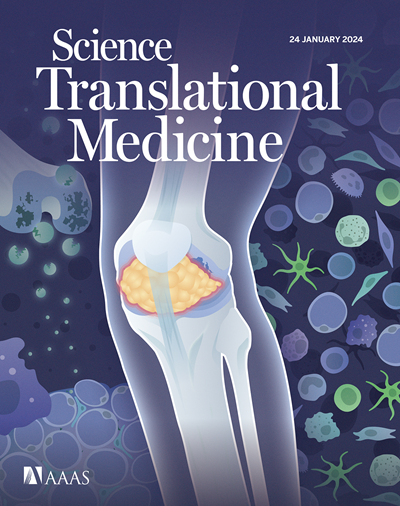电粘水凝胶界面延长猪胃肠道粘膜治疗
IF 15.8
1区 医学
Q1 CELL BIOLOGY
Science Translational Medicine
Pub Date : 2025-02-26
引用次数: 0
摘要
建立一个坚固和亲密的粘膜界面,允许医疗器械在腔内器官内停留较长时间,具有重要的应用价值,特别是在胃肠道治疗方面。在这里,我们报告了一种电粘合水凝胶界面的发展,用于电激活(e-GLUE)后坚固和延长的粘膜保留。e-GLUE装置由阳离子聚合物相互渗透在坚韧的水凝胶基质中组成。e-GLUE电极的设计消除了在内镜下输送过程中需要在粘膜下放置侵入性地电极进行电刺激的需要。通过约1分钟的电刺激处理,阳离子聚合物扩散并与深层粘膜组织中具有相对缓慢的细胞周转率的聚阴离子蛋白相互作用。这种粘膜粘附机制将水凝胶在粘膜上的粘附能提高了30倍,并使e-GLUE装置在猪胃中的体内胃保留时间长达30天。粘附强度受聚阳离子链长度、电刺激时间、凝胶厚度、交联密度、电压振幅、聚阳离子浓度和电极组件的周长比等因素的调节。在猪的研究中,e-GLUE表现出在腔内液体和粘液暴露的情况下快速粘膜粘附。在概念验证研究中,我们展示了e-GLUE在粘膜止血、治疗药物持续局部递送和胃肠道亲密生物传感方面的应用,这是对商业上可用的替代品(如内夹和粘膜粘接剂)的持续临床挑战。e-GLUE平台可以实现一系列消化系统疾病的治疗应用,包括复发性胃肠道出血和炎症性肠病。本文章由计算机程序翻译,如有差异,请以英文原文为准。
An electroadhesive hydrogel interface prolongs porcine gastrointestinal mucosal theranostics
Establishing a robust and intimate mucosal interface that allows medical devices to remain within lumen-confined organs for extended periods has valuable applications, particularly for gastrointestinal theranostics. Here, we report the development of an electroadhesive hydrogel interface for robust and prolonged mucosal retention after electrical activation (e-GLUE). The e-GLUE device is composed of cationic polymers interpenetrated within a tough hydrogel matrix. An e-GLUE electrode design eliminated the need for invasive submucosal placement of ground electrodes for electrical stimulation during endoscopic delivery. With an electrical stimulation treatment of about 1 minute, the cationic polymers diffuse and interact with polyanionic proteins that have a relatively slow cellular turnover rate in the deep mucosal tissue. This mucosal adhesion mechanism increased the adhesion energy of hydrogels on the mucosa by up to 30-fold and enabled in vivo gastric retention of e-GLUE devices in a pig stomach for up to 30 days. The adhesion strength was modulated by polycationic chain length, electrical stimulation time, gel thickness, cross-linking density, voltage amplitude, polycation concentration, and perimeter-to-area ratio of the electrode assembly. In porcine studies, e-GLUE demonstrated rapid mucosal adhesion in the presence of luminal fluid and mucus exposure. In proof-of-concept studies, we demonstrated e-GLUE applications for mucosal hemostasis, sustained local delivery of therapeutics, and intimate biosensing in the gastrointestinal tract, which is an ongoing clinical challenge for commercially available alternatives, such as endoclips and mucoadhesive. The e-GLUE platform could enable theranostic applications across a range of digestive diseases, including recurrent gastrointestinal bleeding and inflammatory bowel disease.
求助全文
通过发布文献求助,成功后即可免费获取论文全文。
去求助
来源期刊

Science Translational Medicine
CELL BIOLOGY-MEDICINE, RESEARCH & EXPERIMENTAL
CiteScore
26.70
自引率
1.20%
发文量
309
审稿时长
1.7 months
期刊介绍:
Science Translational Medicine is an online journal that focuses on publishing research at the intersection of science, engineering, and medicine. The goal of the journal is to promote human health by providing a platform for researchers from various disciplines to communicate their latest advancements in biomedical, translational, and clinical research.
The journal aims to address the slow translation of scientific knowledge into effective treatments and health measures. It publishes articles that fill the knowledge gaps between preclinical research and medical applications, with a focus on accelerating the translation of knowledge into new ways of preventing, diagnosing, and treating human diseases.
The scope of Science Translational Medicine includes various areas such as cardiovascular disease, immunology/vaccines, metabolism/diabetes/obesity, neuroscience/neurology/psychiatry, cancer, infectious diseases, policy, behavior, bioengineering, chemical genomics/drug discovery, imaging, applied physical sciences, medical nanotechnology, drug delivery, biomarkers, gene therapy/regenerative medicine, toxicology and pharmacokinetics, data mining, cell culture, animal and human studies, medical informatics, and other interdisciplinary approaches to medicine.
The target audience of the journal includes researchers and management in academia, government, and the biotechnology and pharmaceutical industries. It is also relevant to physician scientists, regulators, policy makers, investors, business developers, and funding agencies.
 求助内容:
求助内容: 应助结果提醒方式:
应助结果提醒方式:


